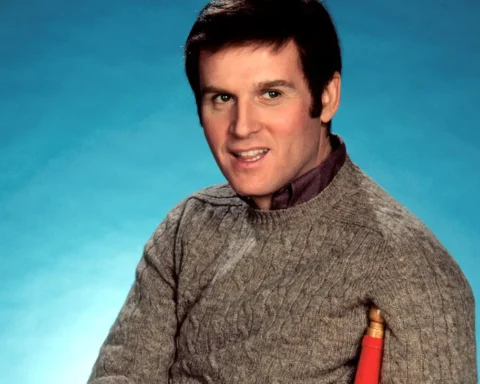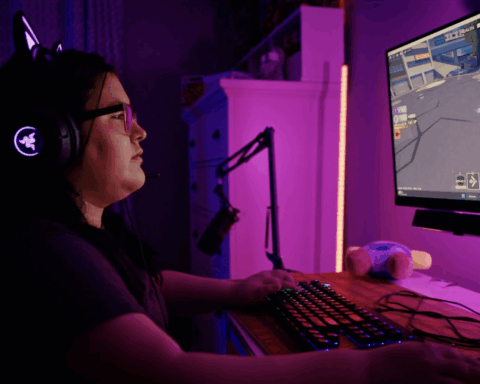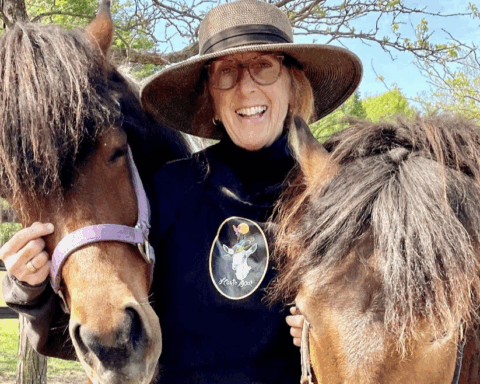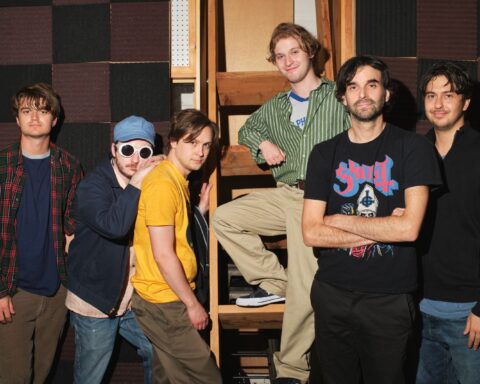One of the key figures in modern cinema, Wim Wenders has created works of style, integrity and ambition in both feature fiction films and documentaries. He’s garnered prizes at Cannes, Lorcano and Venice for such transcendent works as Wings of Desire, The State of Things and Paris, Texas. A philosophical filmmaker with a deep appreciation of music and visual imagery, Wenders has created works that concentrate on landscape—many are road films—and memory. His highly resonant works evince the concerns of a romantic humanist who respects the complex motivations of the characters in his films—and in life.
Like Werner Herzog, his compatriot in the ’70s New German Cinema movement, Wenders has ventured frequently into the field of documentary. Lightning Over Water (Nick’s Film), Wenders’ first feature documentary, is a moving first-hand account of the last days of cult film director Nicholas Ray’s (Rebel Without a Cause, They Live By Night, Johnny Guitar) life. After two short docs, Wenders returned to long-form with two stylish appreciations of Japanese artists: the film director Yasujiro Ozu (Tokyo-Ga) and fashion designer Yohji Yamamoto (Notes on Cities and Clothes).
Wenders hit his stride with his next feature doc, Buena Vista Social Club, which proved to be a worldwide hit and sparked a huge interest in Cuban culture and music. Sticking with music, Wenders next crafted the innovative The Soul of a Man for Martin Scorsese’s Blues TV series. His current film, Pina, is attracting attention across the globe for its innovative use of 3-D and brilliant staging of modern dance. Like many of Wenders’ previous docs, it’s a personal look at an artist—in this case, Pina Bausch, the exceptional choreographer whose pieces transformed modern dance in the past three decades.
POV’s editor Marc Glassman was able to interview Wim Wenders twice about his relationship with documentary filmmaking. In 2009, when Wenders was in town to mentor the first group of senior documentary “students” sponsored by the Canadian Film Centre and the National Film Board to create feature docs, Glassman was allowed to speak to him through the good offices of Jerry McIntosh, the coordinator of the project. Two years later, Glassman interviewed Wenders again, this time during TIFF, when Pina premiered in Canada.
Glassman would like to thank McIntosh, the NFB, the CFC, the Goethe-Institut and Mongrel Media for the kindnesses shown to him by allowing these interviews to occur.
MG: Marc Glassman, POV editor
WW: Wim Wenders
MG: How long did you know Pina Bausch?
WW: We knew each other altogether for a quarter of a century—25 years. She was a little bit like the older sister I never had. We were very close. We were born 20 kilometres apart so Pina and I spoke the same dialect. Living through the ’50s and ’60s, not together but in the same country with the same experience, meant a lot to both of us. When we met, we found that we had lived through a lot of the same things. Pina in her field in dance and I in cinema had gone through the same realization that we had to start from scratch to do something.
I lived in America in the late ’70s and ’80s and completely missed Pina’s rise to fame. I got to meet her first in 1985 in Venice, Italy, where I was for very different reasons. There was a retrospective of six of Pina’s pieces at La Fenice, a beautiful old theatre. I had no idea what it was and had no intention to go because dance, I figured, was not for me. My girlfriend, Solveig Dommartin, had seen Café Müller and she thought that I should absolutely know about Pina and her work. I didn’t want to go. I had other plans for that night in Venice. But I finally caved in and that was a big night in my life when I was confronted first with Café Müller and then Sacré du Printemps (Rite of Spring). I didn’t think that dance could move me, or could even concern me. And I was sitting on the edge of my seat in tears for the entire thing. It just blew me away. Especially Café Müller. What was yet unknown to me Pina Bausch expressed about men and women in that 30 minutes; it was mind blowing. I thought it was more than the entire history of cinema had shown me about the subject.
I immediately prolonged my stay and saw everything. And in that time in Venice, I met Pina. For a quarter of an hour, we had coffee together. That was our first encounter. And in that first encounter I already mentioned a film that we should do together one day. Pina didn’t say anything. I don’t think she said more than “hello” to me and smiled and lit one cigarette after another. And when I mentioned that we should do a film together, she smiled very benignly and again didn’t say anything. So I felt a little foolish. But I was so enthusiastic. And I thought either she didn’t hear it or it was preposterous and she didn’t react to it. But when we met the next time, in Wuppertal a year afterwards, she said to me as if it had been just the other day, “You asked me about a film. That would be a good idea.” And since then it was on the table. For more than 20 years.
When Pina died so abruptly, it seemed so pointless to continue the film that I cancelled it. We called the financiers and co-producers and the whole team and just called it off. But then the dancers, two months later, started to rehearse the pieces that Pina, together with me, had put on the agenda. They reminded me that Pina had rehearsed with the young dancers for it and that her look was still on it. And they also made me understand that it wasn’t obvious that they were ever going to do it again. It could have been the last, because the future of the Wuppertal Dance Theatre was open. It still is.
I realized that Pina would have wanted us to film these pieces. Pina’s motto had always been “Dance or we’re lost.” It’s what she told her dancers each time: “We have to dance.”
Dance for Pina was a way to deal with life and death. So I realized that cancelling the film was the wrong decision and we jump-started the whole thing, but with not much of an idea of how we could conceptually replace Pina. As a first step, all we could do was film and edit those four pieces in their entirety and because Pina would have wanted us to. Some of them are long. But we’ve now finished them and all four of them exist in their entirety. In the film we could only use accents. Then we took a long break and it took me a while to understand that the way to finish the film—because the four pieces were not a movie—was to use Pina’s own method and ask the dancers about her and let them answer with dance.
I had to invent lots of things that we would not have done in the film that Pina and I were going to do together. [In] the film that I wanted to do with Pina, I would have accompanied her a lot, [seen] her working a lot. I would have travelled with her and the company to Korea as well as to South America. And my entire interest and the conception for the film we wanted to do together was her look—a film about these amazing eyes that so patiently watched and watched and then were able to turn what they saw into these pieces. So when Pina was no longer with us, when we started to consider making a film for Pina instead of with Pina, I had to come up with stuff on my own.
I realized that I could only do it with her ensemble, with her dancers. They could still tell me a lot about Pina’s eyes and about Pina’s look. And that I only had to ask the dancers, but not verbally. Just exactly like Pina did. They would not be answering with words, but with their own language—body language. And when I asked them what they could do together as a group, they unanimously said ‘One of the lines.’ Pina had done three or four of these lines. When we looked at the lines that really concerned the entire ensemble, the one from Carnations (Nelken) was the most powerful one because it indicated the four seasons. Spring and Summer and Autumn and Winter. Somehow the entire company going year after year seemed like a great metaphor for them and for life. So I decided to use that line for the beginning, middle and end of the film.
MG: And then to include Wuppertal in the film, was it because the place itself was so important to her and her creativity?
WW: Yeah. I mean, seriously. This body of work is 40 pieces. Pina could not have created that in Berlin or London or Rome or New York. You can’t work so concentrated in the big city, and with that consistency. In Wuppertal, she was unobserved. People loved her, but they left her in peace. And it needed a little city like this one. Wuppertal is not a rich city. Actually, it’s a city in deep depression, economically. This was the only thing that the city of Wuppertal had and did for 30 years: they supported this dance company. It’s their only claim to fame. Because the city so much belonged to Pina, I felt it was important that the city appeared.
And again, the model was given by Pina herself. She did a theatre piece every year except for one: in 1990, she made a movie, The Lament of the Empress. And in that film she left the theatre and shot all over the city. I loved the movie and when I realized I had to continue my film with the dancers and with what they were showing me about Pina, I remembered The Lament of the Empress. So we decided to shoot it also in the city and around the city, in this amazing industrial wasteland.
MG: You haven’t worked with 3-D before. Did you feel that really helped in terms of being able to catch the depth of the dance?
WW: We would not have started the film, Pina and I, if it hadn’t been for the arrival of 3-D. Pina expected so much from our collaboration. She expected that I would film dance differently than I had done before. She was disenchanted with the recordings that had been done of her pieces and I didn’t know how to do it better than people before me. Looking at the history of cinema and watching a lot of dance films, I realized there was a problem between dance and film. Something always got lost. I didn’t dare do this film [for a long time] because I felt my craft just didn’t have what it needed to convey that contagious physical quality of dance. When I saw the first 3-D film, I called Pina right away—from the theatre—and I said, “Pina, I think I know how to do it now.” And that’s when we actually started to prepare the film, in 2007. The film would not exist if it hadn’t been for the arrival of this new medium that gives us filmmakers space as a tool. Space is the kingdom of dancers and dance. And I could enter this kingdom and not be looking from outside in, but be inside it.
MG: You’ve had success in making documentaries and fiction films. That’s a rare combination. What are the strengths of each form?
WW: In a fiction film you decide on your storyline. Your emotional passage is clearer than in documentaries; you set your preferences and you have your leading characters. A lot of that is work-in-progress in a documentary. When you envision your access to the subject, there are many more roads than in fiction. And that can be very adventurous. Even when you’re editing, there are quite often many different ways to go about it, and you only find them during the process. You don’t even know where the backbone of your story is when you’re shooting very often.
MG: You touched on something that I’ve noticed over the years. Editors for documentaries are almost like script editors for narrative films. They are, perhaps, the key collaborator. That may be very different from the way that you would be acting with an editor when you’re doing a fiction film.
WW: It’s a different relationship. Your editor becomes your co-author because a lot of the authorship shapes up in the editing. I very much believe in the power of a good editor. You’ve got to give them credit and let them do their best. And they don’t do their best if they just execute what you tell them to say. They do their best when they really immerse in the material and find pathways through it that you don’t dream of.
Here is one of the stories that I tell about how much the editor is contributing. The Soul of a Man, a film I made about the blues, was edited three times. I edited the film first the way I had conceived it, with Brian Johnson, the same guy that had done Buena Vista Social Club. I did it with first-person narration, by myself, which is the way that we’d gone into the shoot. We completed the whole thing, edited, did a pre-mix, and looked at it for the first time on the screen. And I realized that it was horrendous. The fact that this German fellow was imposing his voice onto three black men [Skip James, J.B. Lenoir, Blind Willie Johnson] who had suffered a lot and been forgotten and created great music was playing wrong. It was pretentious and I hated it. My editor left because he felt it was good and thought that he couldn’t get more out of the material. He thought I was killing it by saying ‘No, I have to start from scratch.’
So I found somebody else and I told her the opposite. I told her, ‘We have to find a way through the material without any narration, because narration doesn’t work.’ We reorganized it completely, from scratch. She really went back to the rushes. Took almost half a year. We made a screening and the result was as disastrous as the first time. This time it just did not hold water. It fell apart, because the three musicians that my film was about lived and worked in three different eras—the ’20s, the ’30s and the ’50s. They had not met each other; they had not influenced each other. There was no connection. I was the only common denominator. With no voiceover, it just was not apparent what the thread of the film was. It fell apart even worse than the first try.
So we had to start from scratch a third time. In a panic, I tried to find an angle that would allow somebody to bring in a narration and a voice to organize the material and link the shoots that were about three different men in three different eras. Three very differently organized shoots. Then I finally remembered a tiny bit of research that had occurred in the preparation of the film. The research was that in the late ’70s when the Voyager mission was launched into space, somebody at NASA had collected data from all over the world to put onto the ship for some culture somewhere in the universe: if they intercepted the Voyager they would know how life on Earth was.
They sent all sorts of documents on life on Earth. It was pre-digital. Mathematic formulas, chemical formulas, presentations of the human race, our genes. All sorts of things. Somebody at NASA had the brilliant idea to add some music, a certain number of pieces from Bach to Mozart and other classical music into the 20th century. There was one piece of blues music selected and that was Blind Willie Johnson’s “Dark Goes The Night.” And “Dark Goes The Night” was the song that opened my film. I had not thought much about it because it seemed to be useless for the film. Then all of a sudden I realized that was my angle. So I made Blind Willie Johnson the impossible voiceover from space, because his voice was out there in space. He had left the solar system already and he was looking down at us. And that was the voice-over [by actor Laurence Fishburne]. And of course, from that distance he’s allowed. My editor Mathilde Bonnefoy thought I was kind of crazy but I thought, ‘This is going to work.’
We wrote to NASA, and NASA is a great organization because you get everything for free. Everything is public domain, whatever they have produced. So they gave us lots of visual material about Voyager and that helped us to reorganize the entire shoot one more time and I wrote the narration for Blind Willie Johnson in outer space. Then the movie finally happened. It took more than a year and a half and three completely different arrangements before I found the right backbone. I think it’s encouraging for filmmakers w documentary ho are arranging their materials for the first time. If they have the feeling that something is missing, all is not lost. You can still play with a lot of different ideas to construct the material. A lot of the great creative work of is in the editing.
MG: Did anything similar to that happen when you were working on Lightning Over Water, your film about the great director Nick Ray?
WW: That was related in its complexity, but different. The difference is that we shot with Nick in ’78 and shooting him became a frenzy because Nick’s health was deteriorating fast. He really forced us and pushed hard to go on shooting. So with less and less of a plan, we shot. The film was, in a sense, more to accompany him than to produce something. It was a way to surround him and go through those last weeks of his life with him. And we would have done it even without film in the camera. The essential thing was to be with him and to do something that made sense and that he was involved in. It gave him the feeling that he was working and he was surrounded by his favourite element, which was a film crew.
We consulted his doctors quite often—desperately, because we didn’t know…‘Can we continue working with a man who is so sick?’ And the doctors said, ‘For heaven’s sake, never stop. What you’re doing is better than any medicine we can do. Because you’re keeping his will to live alive.’ So we continued until the day that it was obvious that it was no longer possible. The pain was too great and he was handicapped by the painkillers. And that was the day when he himself, in the film, says ‘Cut.’
Right after that, the disaster was that I had to go back to Hollywood to do Hammett [a Coppola-produced 1982 noir homage to Dashiell Hammett]. I was under contract with a studio; for the next six months, I was not allowed to work on anything else. I couldn’t even sneak out at night to look into the editing room when my editor came to Los Angeles and rented an editing suite. So Peter Przygodda, who edited my films before and ever since [until his death in 2011], was left on his own. And he sort of resented it because it was such a personal film and the material was so dramatic and so painful. He decided that he was going to do the only possible thing, which was to cut it in the way he saw it—as an outsider who had not been doing the shooting. And I let him do it. Maybe the results of the shoot had been so heartbreaking and we all had undergone such trauma that I didn’t have it in me to go into the editing room and face it again. Peter completely locked himself up in the editing room and was no longer accessible. In his own very painful way, Peter immersed in the project and edited it completely in the third person, without any narration, as somebody who found the material and tried to make sense of it. He actually mixed the movie and made a first print.
When I saw the first print, I realized how much of a coward I had been and that I owed it to Nick to do the film in the first person because I’d been involved. Nick was dead and I couldn’t allow the film [to remain] in the third person. I had to do it in the first person. I owed that to Nick.
We showed Peter’s cut in Cannes. It played once in my absence. I was still shooting Hammett; I couldn’t possibly go. It screened once publicly and then I took the only print and went back into the editing room, because there was a break in Hammett for three months. I did the same thing that Peter had done: I locked myself up with all of the material without an assistant, without any help, in an editing suite in Los Angeles and recut the entire film, this time with a narration in the first person, and remixed the film. It has nothing much to do with the first cut because it’s such a different thing, telling it in the first person and telling it in the third one. And I kept Peter’s print. It’s at the Cinematheque in Munich. Just for reference. If anybody ever wants to look at both cuts, they can see what happened from a structuralist point of view, because it’s not done too often that a film is actually organized in two different ways. So if anybody wants to study it, it’s there. But ever since, my own version has been in release.
MG: It seems that you and I share a favourite film, which is Sans Soleil. To me, it’s an example of how far a documentary can go in terms of narrative strategy. I’m fascinated by the whole notion of displaced narration with a series of letters that may or may not have existed between two characters that may be real or may not be real. I’m wondering if you could comment on that, because it’s a film that I go back to over and over again.
WW: I really wonder if Chris Marker had the [narration] idea in mind when he started shooting. It would be interesting to find out. I doubt it, myself, because Chris is also a guy who spends a long time in the editing process. And I guess he wouldn’t spend so long if he had it already planned out. He would be done quickly. A lot, I think, is the editing work. And the editing is part of the creative work in this case, intended to bring the best out of the material. To make it sort of shine.
MG: Do you always find pleasure in the process of making films, even though sometimes it’s a real struggle to find a proper way to organize them?
WW: I think it’s very rare that you make a film where there are no obstacles to overcome and everything runs smoothly. And it’s very rare that such experiences turn into a good movie. In my own experience, those films where you really stood in front of a mountain of problems and had to overcome huge difficulties, where you were heartbroken that you couldn’t do things and you had to come up with ideas in order to cover up for something— those are the interesting films. Those are really the films that count, not the films where everything goes smoothly. They rarely have that power afterwards. I think the films that break your heart in between also have the potential to break other people’s.
MG: A number of fiction film directors have told me that when you cast the right actor, your work is nearly done. I’m wondering how that translates into doing documentaries. After all, you have to cast real people.
WW: In documentaries it’s even more crucial. I think Hitchcock said that 90% of the director’s work is done with the casting. Maybe he was exaggerating a little bit. Maybe it was just 60 or 70 percent. But I guess it’s up there. In documentary you might almost say it’s 100% because you rely for the entire truth of the film on the personalities of the people you choose. And you don’t have the freedom to tell them ‘Let’s do another take and this time be a little bit more convincing.’ You can’t do that. With an actor, you can shape the character. But in a documentary if you start shaping the character, you’re no longer doing a documentary. So it’s even more important.
Take Buena Vista Social Club. I mean, it was these old men and they were 100% of the film. They were 200% of the film because they were not just one, they were half a dozen. And everybody was 100% right, so I felt like I had a case of much more than 100%.
MG: Was it difficult because it is one of those films that has so many fascinating people? How do you give everybody their proper time in a situation like that?
WW: There was never really a question of balance because between them there was no competition, apart from Compay Segundo, who was very severe with everybody else. They were all scared of him because he was like the General and what he said really mattered. But he was only there for the first two days and then he left. But for everybody else…there was no competition and no struggle for position and no struggle to have centre stage. They were all extremely caring and really interested in the music and in getting everybody else’s best, not only their own. Considering that I spent so much time on it—almost three different shoots and over a year in editing—it never became work. Even in the editing process, it never felt like ‘Well, I have to go to work.’ It was never that. It was always a pleasure to just listen to them and the music. Even for the 500th time, it was still exciting.
MG: Has there been a particular pleasure for you in realizing what a treasured and important film Buena Vista Social Club has become? It opened up so many people to an appreciation of a different kind of music and culture.
WW: Well, it’s certainly a different kind of feeling if you’re involved in a movie that changes people’s lives—in this case, really, all of the lives of these people that were in front of the camera. That does not always happen if you do a documentary that it has an immediate impact on the situation. Very often you wish for that to happen. Very often you make the film in order for something to change. But it’s never been as radical [for me] as in this case. We didn’t only have an impact on these 12 people, we had an impact on an entire country. That is also something you never ever expect. You don’t go about making a movie saying ‘I’m going to change the future of Cuba.’
MG: But it’s nice if it happens.
WW: And it did happen. It put Cuba back on the map in a political way. So it’s very rewarding when a film has that effect, but on the other hand, you cannot really pat yourself on the shoulders. It wasn’t intentional so I can’t take the credit for it. I wanted to make a film about the music and about these amazing men who believed in that music against all odds. Who believed that it would still survive even though others thought it was long dead. And it did survive.
MG: It seems to me that when we talk about documentary, we also talk about ideas that incorporate fiction. I’m wondering about that idea of a mélange between the two.
WW: I think we have to acknowledge the fact that lives are full of fiction and that we experience amazing things. We make movies about people who experience things that sometimes really belong to the realm of fairy tales, like Buena Vista Social Club. I went to Havana and Ibrahim Ferrer still had the box with his shoe shine stuff standing there ready to go out any day, ready to go out and continue his job. And at the end of the shoot, here he was standing in a red jacket, centre stage at Carnegie Hall and 1,000 people were in their seats. And he would never have to shine shoes again. So that is a fairy tale. And if you would write it, people would criticize you because they’d say ‘It’s a little corny what you’re writing here. Don’t you think it’s happening too fast?’ (Laughs)
MG: Does it come back to what Godard once said about film being truth-telling in 24 frames per second?
WW: Yeah. It has come back to that in a very unexpected way and maybe especially because so many feature films have drifted away into formula or fantasy. So the documentary has regained its position also because the fictional film has drifted away from reflecting reality more and more. It’s rare that a fictional film still has its roots in real situations.
MG: Do you feel that your work is changing? You’ve made a short film for the UN Person to Person on sustainability and you’re mentoring young filmmakers, including documentarians here in Canada. Is your role shifting? Do docs fascinate you more?
WW: I think it’s not so much that I, as a filmmaker, have drifted into a different vein. It’s more that the overall landscape into which we make movies today, I feel, demands a different sort of responsibility from filmmakers. And cinema has clearly taken up a different role in the last 20 years. Especially documentary films. In a time where television has basically lost both its function of informant of news and the informant of opinions, I think documentaries have regained the position they had in the very beginning. And that is, I think, not my own personal decision on my path as a filmmaker. I think it’s the different role that films play in society today, and the new role that documentary has acquired over the last 10 or 20 years.











